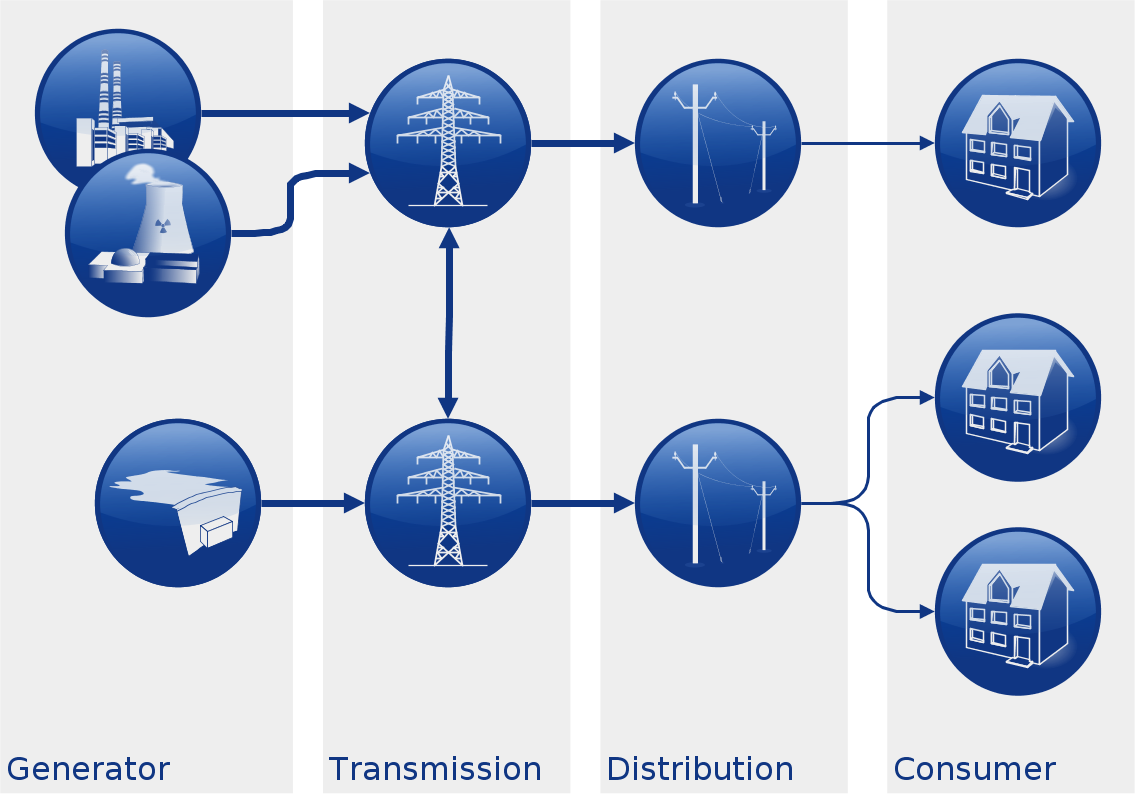When it comes to industrial control systems (ICS) specifically to supervisory control and data acquisition (SCADA) then a basic unterstanding of the business is crucial. In the curse of my master thesis I am currently digging into parts of the electrical grid and try to examine the issues and security level of some specific protocols. Thus, I will regularly keep you posted on grid aspects over the next two months
For a starter, this article shall give a short introduction into electrical grids in general. It aims to introduce general terms and to state the difference between the former electrical grid architecture and the smart grid. Additionally, paradigm changes and challenges [1] to the current grid will be pointed-out and the conclusion will include some reasoning for a more flexible architecture – the smart grid.
Electrical grids consist of power plants that create electricity from some form of energy. They consist of towers and poles that hold wires to transport the electricity and finally make it available to the consumer. The figure provides an overview how these facilities are logically grouped into four major electric grid domains. The domain concept is not entirely new and was similarly outlined in a description of cyber security on the essential parts of the smart grid [2].

Generator domain; includes all sort of bulk power generation plants such as nuclear reactors, fossil fuel (coal or gas) plants as well as hydroelectricity plants. Typically, these are power plants that can continuously generate electricity of several hundred million watts (MW).
Transmission domain; represents the long-distance transmission network components. This includes components such as large interconnection nodes, substations and of course, cables either mounted on towers or buried underground. Electrical lines at this domain normally work on very high voltage. The voltage for that size of transmissions networks is several hundred of thousand volts (kV). Among Europe typically values are 230kV and 400kV. Traditionally, the domain is under control of the transmission system operator (TSO). In some countries a national body or a super body of utilities operates that domain.
Distribution domain; provides the whole infrastructure to bring power to the end user (consumer). The domain also includes transformer equipment which is necessary to reduce the voltage as power is transported to the consumer. Bulk consumers typically get their power at higher voltages, for example 16kV, then common house holds for which 230 Volts and 400 Volts present common values. The domain is manged by the so-called distribution system operator (DSO).
Consumer domain; groups all sort of consumers. The industries as well as household regardless of the amount of consumption and the consumer geographic location.
The four domain model gives a good introduction into the basic concept of an electrical grid but it does by no means appreciate the full detail of the electrical grid nor does it fully model the energy flow. Due to the liberalization of the power market the generation domain is not exclusively subject to large utilities anymore. For example, consumers may want to invest into renewable energy such as photo voltaic (PV) equipment in order to cover their own power consumption and to supply current out of surplus production to others. Thus, “consumers are becoming producers or producing consumers – prosumers” [3].
Comparable changes also apply to the distribution domain. Local utilities more frequently setup own facilities to generate power which will be feed-in directly at the distribution level at high voltages. Distributed generation (DG) is nothing new to grid operators and utilities as it was already discussed in literature [4] in 2001. The referenced book [4] does also introduce several forms of generators and does recognize the technical and financial impact of distributed generation to the grid. The reader will find information on combustion turbines, PV systems, micro turbines, fuel cells, combined heat and power as well as background information on grid operations with distributed generation and storage. However, security relevant aspects are not being discussed.
Since 2001 distributed power generation significantly emerged due to renewable energy got political attention and national funding [5]. These fundings do not only focus on large installations but also take small generators in home scale into account. Meanwhile, distributed generation has taken off and demands for advances in measurement and operations of the electrical grid. Only the introduction of additional information technology (IT) will allow to coordinate all generators, storages and consumers and thus to ensure efficiency and reliability of the grid.
A functional and reliable grid is evident for a country’s stability. Therefore, governments provide guidance in form of critical infrastructure protection (CIP) programmes [6,7] and in form of written recommendations [8,9] on how to securely operate the IT stuffed new generations of grids.
References
[1] European Commission, Energy Efficiency Plan, 2011
[2] United States of America, H.R. 6582: American Energy Manufacturing Technical Corrections Act, 2012
[3] P. Hasse, Smartmeter: A technological overview of the German roll-out, 29th Chaos Communication Congress, Online http://events.ccc.de/congress/2012/Fahrplan/events/5239.en.html, 2012
[4] A. Borbely and J.F. Kreider, Distributed Generation: The Power Paradigm for the New Millenium, CRC Press, 2001, ISBN 0-8493-0074-6
[5] European Commission for Energy, Financing Renewable Energy in the European Energy Market, 2011
[6] North American Electric Reliability Corporation (NERC), http://www.nerc.com/
[7] Federal Office for Civil Protection (FOCP), The Swiss Programm on Critical Infrastructure Protection, Nov 2010, Online http://www.bevoelkerungsschutz.admin.ch/internet/bs/en/home/themen/ski. parsysrelated1.82246.downloadList.18074.DownloadFile.tmp/factsheete.pdf
[8] NIST Cyber Security Coordination Task Group, Security Profile for Advanced Metering Infrastructure, v2.0, June 2010
[9] ENISA, Smart Grid Security: Recommendations for Europe and Member States, July 2012, Online http://www.enisa.europa.eu/activities/Resilience-and-CIIP/critical-infrastructure-and-services/smart-grids-and-smart-metering/ENISA-smart-grid-security-recommendations/at_download/fullReport
Note, this work is a preview version of an MSc Information Security dissertation in the fields of electrical grids.
Leave a Reply